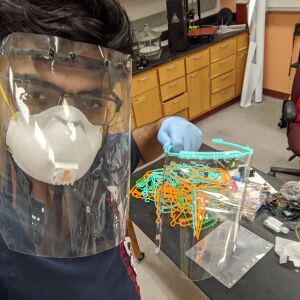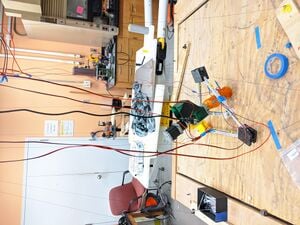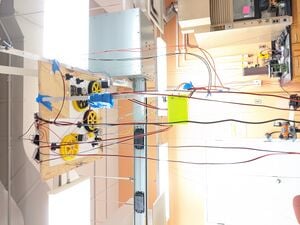
A Materials Science Engineer with a graduate masters degree along with research experience in materials processing and characterization mainly focusing on Additive Manufacturing. I am a lot into cars since I was a child and more into how things are made and what are they made up of(cuz each and everything has to be made up of something). I am a graduate researcher associated with the Michigan Tech Open Sustainability Technology Lab(MOST).
Projects
Distributed manufacturing of PPE through opensource technologies
Due to the Covid-19 pandemic and the disturbances caused in supply of PPE our research group has started researching on Distributed manufacturing of PPE through Open Source 3D printing [1]. I along with my fellow researchers and professor have analyzed various designs of face shields, face masks and hands free door handles and went on producing and supplying over 2500 face shields primarily for healthcare workers and first responders through Western Upper Peninsula Health Department(WUPHD).

Waste plastic direct extrusion with Hangprinter[[1]]
3D printers with capability to print large prints do usually consists of complex mechanisms, large parts and often takes in advanced engineering and controls and are also bulky in size. The hangprinter uses simple mechanism, with smaller parts and have the advantage of being not bulky in size. The main advantage of hangprinter design and approach is its scalability to print components of various sizes, The design of the hangprinter makes it easy to scale the size of print bed based on arranging and fixing few components and parts of it. It consists of two main segments which include a ceiling plate and a carriage, The ceiling plate holds a couple of motors, gearing, spools and linerollers arranged in a way to hold up the carriage and provide movement to it in vertical and horizontal directions. The carriage holds the extruder and is scalable based on the size of extruder to reduce the usage of materials as needed and the control of carriage is done with the help of movement of strings in a particular manner according to the firmware settings and software. The recyclebot extruder is a device that functions to extrude filament from pellets/shredded recyclable plastics by a mechanism that makes the pellets to travel through different heat zones where they are heated and cooled and finally extruded through a nozzle to obtain the filament. Though this device is meant to extrude filament it can also be used as extruder where the extruded material through nozzle can be used directly to print parts. This project includes work on combination of hangprinter technique and recyclebot as extruder to build a hybrid machine that is capable of printing large and wide components along with maintaining the sustainability of using a waste plastic extrusion technique. The components of hangprinter are printed based on opensource materials published by Tobben using a Lulzbot Taz6 3D Printer out of which few components are modified and few parts are newly designed to adjust the assembly according to the new hybrid printer. Electronics usage include Arduino Mega+Ramps 1.4 combination along with nema17 and nema23 stepper motors along with corresponding motor drivers. Marlin firmware based on configurations published on opensource platforms is used in this hybrid printer along with modifications to accommodate extrusion with recyclebot instead of fused filament extrusion. Material selection, spooling and arranging the strings plays a crucial role in the hangprinter design, The selected material for string must be able to hold up and bear the weight of recyclebot+carriage and must be able to have the capability of withstanding the movements caused in them when the printer is in operation with strings being held in tension all the time. A total of five stepper motors will be used in the operation of this hybrid printer where one motor is used for extrusion through recyclebot and the rest four motors to control the movement of carriage + recyclebot assembly vertically and horizontally based on marlin firmware with configurations feeded and calibration done.


Research study of Cast Aluminum alloy engine blocks used in Automobiles
Materials for engine blocks in I.C engine based automotives play a crucial role in their contribution towards a vehicle’s performance and engine life. Since the birth of automotives Cast Iron was used for making Engine block castings and then the automotives had a very high life and all the automotive manufacturers relied on them. In recent years due to improvement and new discoveries in the discipline of metallurgy and development of new materials has led to usage of Aluminum-Silicon based A4xxx alloy series for casting of Engine blocks. Besides the development of new materials the most important desire for weight reduction, increased engine performance and fuel efficiency has led the automotive manufacturers choose Aluminum alloy based material for production of engine blocks and in the current market usage of Cast Iron based Engine blocks has been almost dumped out by the Automotive manufacturers and Aluminum based alloys are widely used. The study on fatigue caused due to nucleation and propagation of microcracks in the alloy have been deeply studied.
X-Ray diffraction techniques and its application on alloys
I have gained hands on experience on material characterization through applying X-ray diffraction techniques to various binary alloys. Have gained hands on operating X-ray sprectrometer and analyzing data using Scintag DMSNT and MDI JADE saftware.
Phase diagram modelling of alloys and study of phase transformations
Has Successfully modeled phase diagrams for various given alloy systems based on chemical properties of elements and Studied Driving forces for phase transformations, nucleation growth, casting solidification, spinodal decomposition, eutectic and eutectoid transformations.